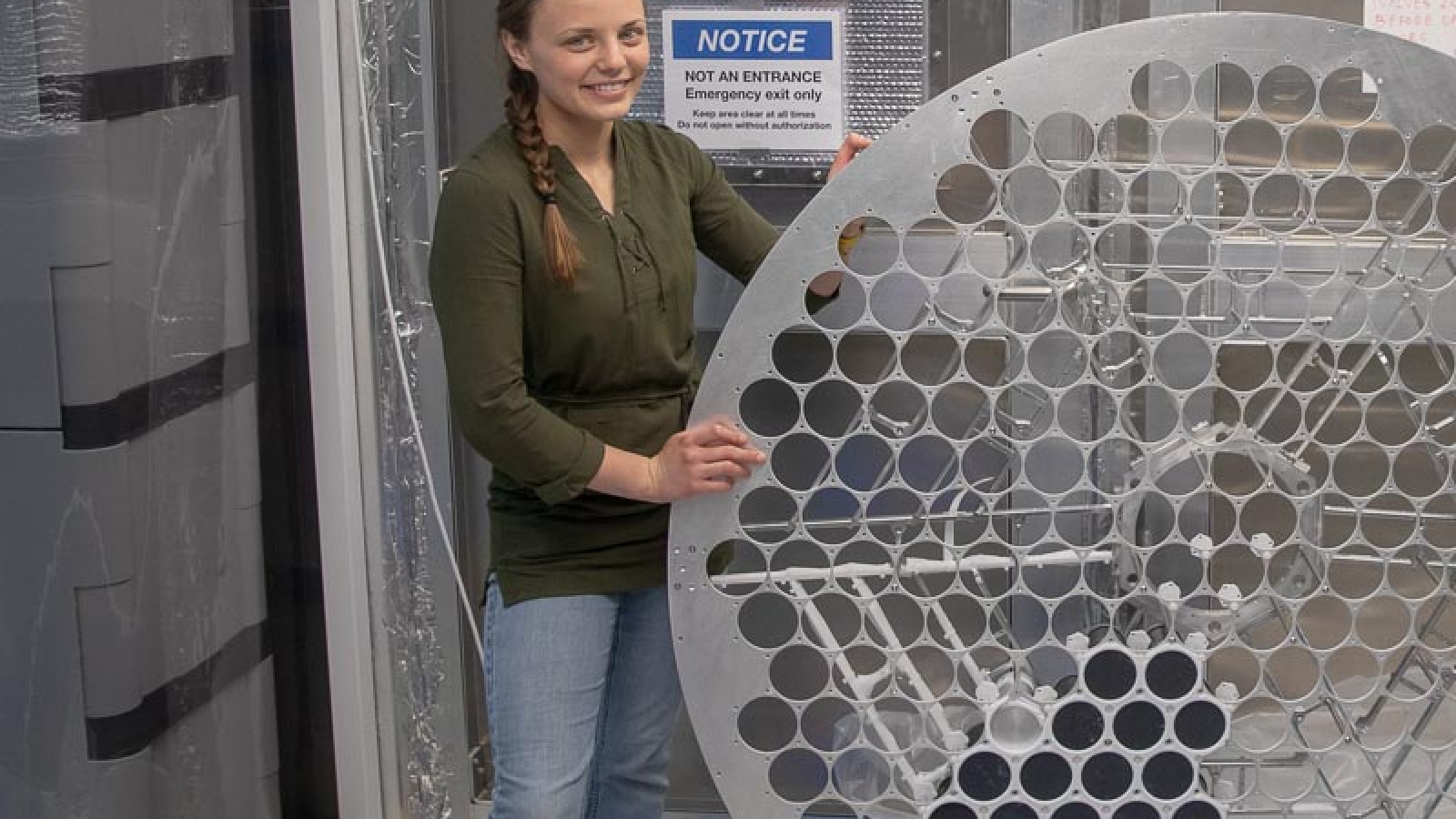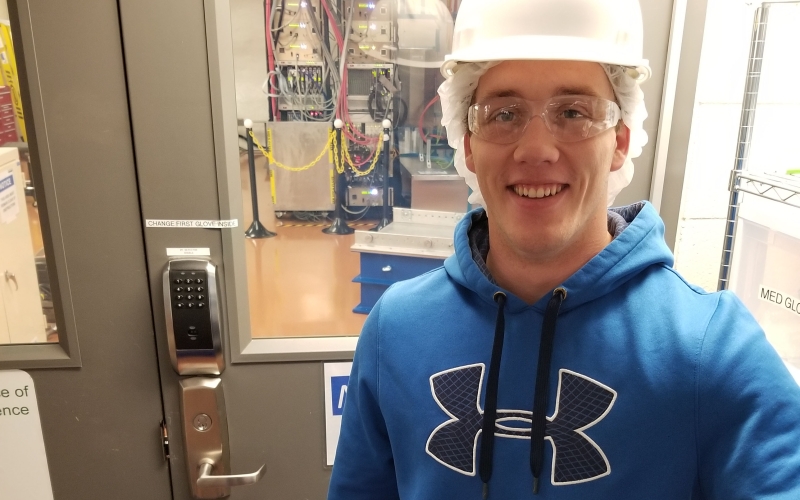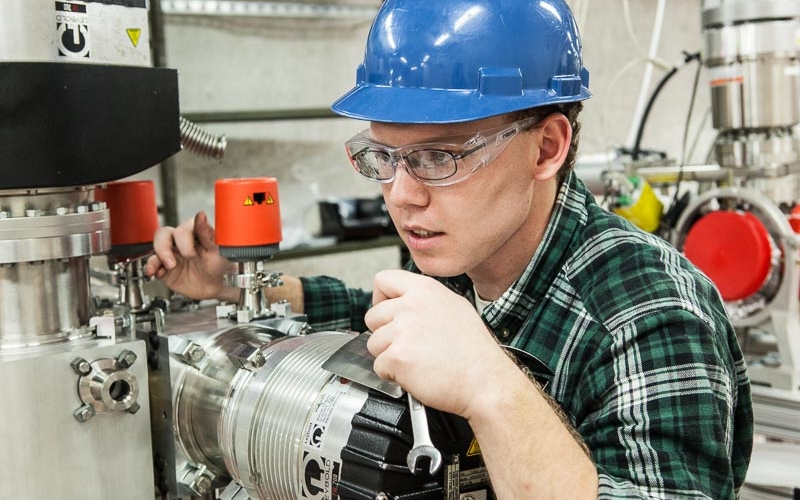
Erica Redinger holds a test array used by LZ to practice installing photo multiplier tubes in the experiment.
Research institutions around the globe propel research that helps us better understand our universe. All too often, however, undergraduate students don't have the opportunity to participate in hands-on research on relevant projects in their field. According to Dr. Brianna Mount, director of the Black Hills State University Underground Campus (BHUC) at Sanford Underground Research Facility (Sanford Lab), those opportunities are critical.
“Research kept me in physics," Mount said. "As an undergrad, you take the introductory physics courses and spend time calculating how fast a ball rolls down a hill. The logical thought process and the fundamental principles of physics are there, but, in reality, I don't spend my days calculating how fast balls roll down hills."
Mount, an assistant professor of physics at BHSU, has multiple undergraduate students working with her each semester at the BHUC on the 4850 Level of Sanford Lab. There, students work with Mount and Sanford Lab staff to provide technical support and to assay materials in low-background counters. This support includes changing samples in the counters, monitoring the liquid nitrogen systems that purge radon from inside the detectors and assisting the installation of counters underground. These services allow researchers to remotely assay the radiopurity of materials that will be used in particle physics experiments around the world. At the BHUC, undergraduate students can actively participate in real scientific inquiry.
One such student is Erika Redinger, a junior physical science major at BHSU. Redinger began working with Mount in the BHUC last fall, learning first-hand how low-background counters use gamma-ray spectroscopy to analyze the amount of radioactivity in a given material. Then, after months of providing support to experiments, Redinger got hands-on experience with an experiment itself. In January, she began working on the LUX-ZEPLIN (LZ) dark matter detector—both on the 4850 Level and at the Surface Assembly Lab.
“I was an extra pair of hands for the underground assembly, and on the surface I’ve been helping build a huge nylon cover to protect the Outer Cryostat Vessel, creating covers for many of the cables and doing some cleaning, as well,” Redinger said.
Now, Redinger is applying this knowledge to an experiment of her own as part of her undergraduate capstone research at BHSU. For this project, Redinger works with Dr. Andy Johnson, assistant professor of physics at BHSU, to design, build and use a low-background counter.
“Dr. Johnson is an environmental physicist who wants to understand the different levels of radiation of in soil and water samples in the region,” Redinger said. The best way to monitor these levels is by using gamma-ray spectroscopy—the same experimental principles employed in the BHUC at Sanford Lab.
“We know a lot of places around the Black Hills have high amounts of uranium and radon, a daughter product of uranium. By counting as many samples as possible, we can begin to characterize the area and quantify just how much uranium is present,” Redinger said.
Redinger said this project could serve as a background for proposed uranium mining, allowing environmentalists to monitor mining impacts on uranium levels and the local environment over time.
While the principles remain the same, Redinger said there are some marked differences between her project and the low-background counters at the BHUC.
“I first learned about gamma-ray spectroscopy in the context of really pure substances, where you didn’t want radioactivity in them,” said Redinger. “Now, with this project, I'm using soil samples that we know are very radioactive, and purposely putting them in our detectors.”
By doing her own research, Erika was able to expand her experience to the electronics involved in gamma-ray spectroscopy. “This part has been really fun for me because the electronics are very simple, compared to the germanium detectors at the BHUC. I've been learning the data analysis, and that's been really fun—a challenge, too,” she said.
After graduation in the fall of 2019, Redinger plans to move overseas to Finland, where she hopes to work in a laboratory dedicated to particle physics or enter a graduate program—or both.
“Your whole college career is spent learning all about this science, and you must get involved with a professional who is active in that field, doing research, to decide if you actually like it—it’s vital,” said Mount. “In particular, I think Erika has changed the direction of her career because of her research experience at Sanford Lab."
Becoming a scientist is a three-part series focusing on the process that students take to becoming full-fledged scientists. The series will continue next week with a Ph.D. candidate from the University of South Dakota. Although each one represents a different stage of education—undergraduate, graduate and post-doctoral—each is already contributing to international science collaborations.


